Donkey Konga (series): Difference between revisions
From the Super Mario Wiki, the Mario encyclopedia
Jump to navigationJump to search
Raymond1922A (talk | contribs) Tag: Mobile edit |
m (Text replacement - "{{([Ss]erials|[Rr]elease)\|" to "{{flag list|") |
||
| (30 intermediate revisions by 10 users not shown) | |||
| Line 1: | Line 1: | ||
{{italic title | {{italic title}} | ||
{{series infobox | |||
{{series | |image=[[File:Donkey Konga logo.jpg|250px]] | ||
|image=[[File: | |||
|first=''[[Donkey Konga]]'' ([[List of games by date#2003|2003]]) | |first=''[[Donkey Konga]]'' ([[List of games by date#2003|2003]]) | ||
|latest=''[[Donkey Konga 3 | |latest=''[[Donkey Konga 3 JP]]'' ([[List of games by date#2005|2005]]) | ||
|number=3 | |number=5 (3 main, 2 browser) | ||
| | |franchise=''[[Donkey Kong (franchise)|Donkey Kong]]'' | ||
}} | }} | ||
The '''''Donkey Konga''''' series is a | The '''''Donkey Konga''''' series is a series in the [[Donkey Kong (franchise)|''Donkey Kong'' franchise]] developed by [[Bandai Namco Entertainment|Namco]]. It comprises three [[Genre#Rhythm games|rhythm game]]s released exclusively for the [[Nintendo GameCube]]. The games are heavily based on Namco's long-running ''{{wp|Taiko no Tatsujin}}'' series of arcade rhythm games, featuring identical gameplay and graphical elements but different tracklists and ''Donkey Kong''-themed visuals. The main distinguishing feature of the series is support for the novelty [[Nintendo GameCube#DK Bongos|DK Bongos]] controller (sold separately or bundled with some releases of the games) to drum the selected song. | ||
This series eventually inspired the creation of ''[[Donkey Kong Jungle Beat]]'', which also supports the use of the DK Bongos. | |||
{{br}} | |||
==Installments== | ==Installments== | ||
===''Donkey Konga''= | ===Main games=== | ||
[[File:Dkk.jpg| | {|align=center width=100% class="wikitable" | ||
'' | |- | ||
!style="background-color: #d9d9d9;font-size:125%;text-align:left"colspan="2"|Title | |||
== | |- | ||
[[File:Dkk2.jpg| | !width=15% style="background-color: #e0e0e0;"|Cover, original release and system | ||
'' | !width=85% style="background-color: #e0e0e0;"|Synopsis | ||
|- | |||
= | !colspan="2"style="font-size:125%;text-align:left"|''[[Donkey Konga]]'' | ||
[[File:Donkeykonga3.jpg| | |- | ||
|style="text-align:center"|[[File:Dkk.jpg|145x145px]]<span style="font-size:8pt"><br>{{flag list|Japan|December 12, 2003}}[[Nintendo GameCube]]</span> | |||
{{ | |'''''Donkey Konga''''' is the first installment in the ''Donkey Konga'' series. It was released for the [[Nintendo GameCube]] in 2003 in Japan and in 2004 overseas. The game has four gameplay modes to choose from: "Street Performance," "Challenge," "Battle," and "Jam Session"; all (except Challenge) have three levels of difficulty modes. Many songs are available to play, including the [[DK Rap]] from ''[[Donkey Kong 64]]''. [[Donkey Kong]] is playable in all modes, whereas [[Diddy Kong]] is the second player in multiplayer. As the first game in its series, it is also the first to support use of the bongos. | ||
|- | |||
!colspan="2"style="font-size:125%;text-align:left"|''[[Donkey Konga 2]]'' | |||
|- | |||
|style="text-align:center"|[[File:Dkk2.jpg|145x145px]]<span style="font-size:8pt"><br>{{flag list|Japan|July 1, 2004}}[[Nintendo GameCube]]</span> | |||
|'''''Donkey Konga 2''''', marketed in Japan as ''"Donkey Konga 2: Hit Song Parade!"'', is the second installment in the series. It was released for the GameCube in 2004 in Japan and in 2005 overseas. While the game has similar gameplay to that of the first ''Donkey Konga'', a few new modes appear in this game, including "Concert," "Freestyle Zone," and "Music Lab." Donkey Kong and Diddy Kong appear once again as playable characters, with the addition of [[Dixie Kong]]. Unlike the previous entry, the game has an ESRB rating of T instead of E (for mild lyrics). | |||
|- | |||
!colspan="2"style="font-size:125%;text-align:left"|''[[Donkey Konga 3 JP]]'' | |||
|- | |||
|style="text-align:center"|[[File:Donkeykonga3.jpg|145x145px]]<span style="font-size:8pt"><br>{{flag list|Japan|March 17, 2005}}[[Nintendo GameCube]]</span> | |||
|'''''Donkey Konga 3 JP''''' is the third and last installment in the ''Donkey Konga'' series. It was released only in Japan on 2005 for the GameCube. The three playable characters from the previous installment are available, as well as [[Funky Kong]]. As the game once again supports bongo use, [[clap]]ping is also used during the songs. | |||
|} | |||
===Flash games=== | |||
{|align=center width=100% class="wikitable" | |||
|- | |||
!style="background-color: #d9d9d9;font-size:125%;text-align:left"colspan="2"|Title | |||
|- | |||
!width=15% style="background-color: #e0e0e0;"|Title screen, original release and system | |||
!width=85% style="background-color: #e0e0e0;"|Synopsis | |||
|- | |||
!colspan="2"style="font-size:125%;text-align:left"|''[[Donkey Konga Beat]]'' | |||
|- | |||
|style="text-align:center"|[[File:DonkeyKongaBeat1.png|145x145px]]<span style="font-size:8pt"><br>August 2004<br>{{wp|Adobe Flash}}</span> | |||
|'''''Donkey Konga Beat''''' was an {{wp|Adobe Flash}} game inspired by ''[[Donkey Konga]]''. It was released in August 2004 through [[Camp Hyrule]]. The game is a ''{{wp|Simon (game)|Simon}}''-type game, where the "Computer" will play either the left drum, clap or the right drum. The player must mimic the computer's sequence of movements, as it adds on one action per round. Players would compete for high scores for how many rounds they could last. The left drum would be pressed with the "D" key, the right drum with the "K" key and clapping was performed with the space bar. | |||
|- | |||
!colspan="2"style="font-size:125%;text-align:left"|''[[Donkey Konga 2 (Flash game)|Donkey Konga 2]]'' | |||
|- | |||
|style="text-align:center"|[[File:DonkeyKonga2flashgame.png|145x145px]]<span style="font-size:8pt"><br>2005<br>{{wp|Adobe Flash}}</span> | |||
|'''''Donkey Konga 2''''' is a Macromedia Flash advergame themed after the Nintendo GameCube game of the same name. It was developed by Nintendo and published in 2005. | |||
|} | |||
{{Game series}} | |||
{{Donkey Kong games}} | |||
[[Category:Game series]] | [[Category:Game series]] | ||
[[ | [[it:Donkey Konga (serie)]] | ||
Latest revision as of 20:09, September 27, 2024
| Donkey Konga | |
|---|---|
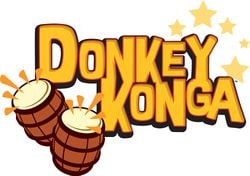
| |
| First installment | Donkey Konga (2003) |
| Latest installment | Donkey Konga 3 JP (2005) |
| Number of installments | 5 (3 main, 2 browser) |
| Franchise | Donkey Kong |
The Donkey Konga series is a series in the Donkey Kong franchise developed by Namco. It comprises three rhythm games released exclusively for the Nintendo GameCube. The games are heavily based on Namco's long-running Taiko no Tatsujin series of arcade rhythm games, featuring identical gameplay and graphical elements but different tracklists and Donkey Kong-themed visuals. The main distinguishing feature of the series is support for the novelty DK Bongos controller (sold separately or bundled with some releases of the games) to drum the selected song.
This series eventually inspired the creation of Donkey Kong Jungle Beat, which also supports the use of the DK Bongos.
Installments[edit]
Main games[edit]
| Title | |
|---|---|
| Cover, original release and system | Synopsis |
| Donkey Konga | |
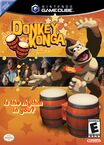 Nintendo GameCube |
Donkey Konga is the first installment in the Donkey Konga series. It was released for the Nintendo GameCube in 2003 in Japan and in 2004 overseas. The game has four gameplay modes to choose from: "Street Performance," "Challenge," "Battle," and "Jam Session"; all (except Challenge) have three levels of difficulty modes. Many songs are available to play, including the DK Rap from Donkey Kong 64. Donkey Kong is playable in all modes, whereas Diddy Kong is the second player in multiplayer. As the first game in its series, it is also the first to support use of the bongos. |
| Donkey Konga 2 | |
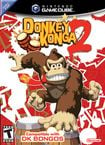 Nintendo GameCube |
Donkey Konga 2, marketed in Japan as "Donkey Konga 2: Hit Song Parade!", is the second installment in the series. It was released for the GameCube in 2004 in Japan and in 2005 overseas. While the game has similar gameplay to that of the first Donkey Konga, a few new modes appear in this game, including "Concert," "Freestyle Zone," and "Music Lab." Donkey Kong and Diddy Kong appear once again as playable characters, with the addition of Dixie Kong. Unlike the previous entry, the game has an ESRB rating of T instead of E (for mild lyrics). |
| Donkey Konga 3 JP | |
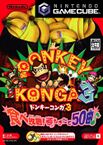 Nintendo GameCube |
Donkey Konga 3 JP is the third and last installment in the Donkey Konga series. It was released only in Japan on 2005 for the GameCube. The three playable characters from the previous installment are available, as well as Funky Kong. As the game once again supports bongo use, clapping is also used during the songs. |
Flash games[edit]
| Title | |
|---|---|
| Title screen, original release and system | Synopsis |
| Donkey Konga Beat | |
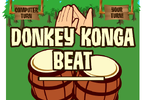 August 2004 Adobe Flash |
Donkey Konga Beat was an Adobe Flash game inspired by Donkey Konga. It was released in August 2004 through Camp Hyrule. The game is a Simon-type game, where the "Computer" will play either the left drum, clap or the right drum. The player must mimic the computer's sequence of movements, as it adds on one action per round. Players would compete for high scores for how many rounds they could last. The left drum would be pressed with the "D" key, the right drum with the "K" key and clapping was performed with the space bar. |
| Donkey Konga 2 | |
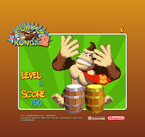 2005 Adobe Flash |
Donkey Konga 2 is a Macromedia Flash advergame themed after the Nintendo GameCube game of the same name. It was developed by Nintendo and published in 2005. |